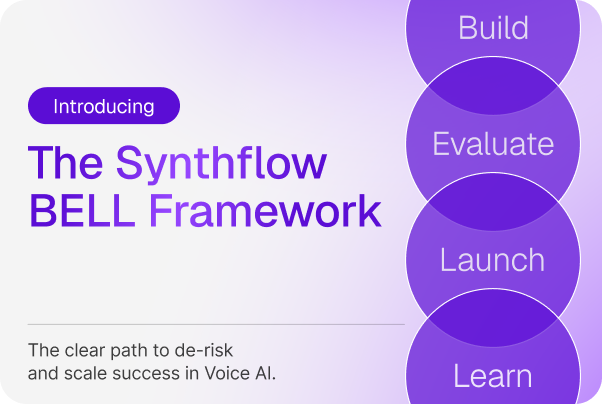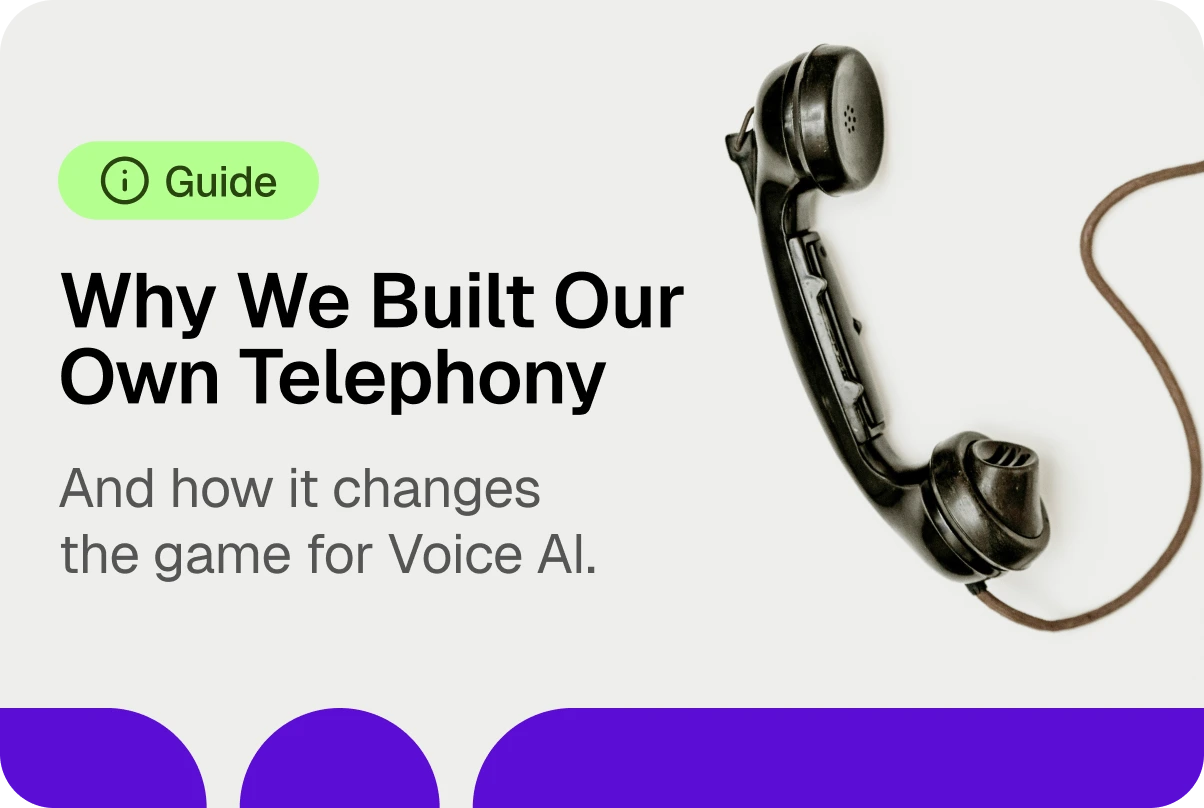Product
Introducing the Synthflow BELL Framework: The New Standard for Enterprise Voice AI

Table of Contents

Enterprises have automated everything except the one thing customers still trust — the phone.
But building a reliable AI voice agent has always been harder than it looks. Models are only one part of the equation. Enterprises also need predictable logic, realistic testing, low-latency telephony, and continuous improvement at scale.
For the past year, we’ve been building something that connects all of that — from design to deployment — into one unified system.
Today, we’re proud to introduce the Synthflow BELL Framework — a new enterprise standard for designing, testing, and scaling Voice AI Agents that de-risk every stage of deployment.
Why Voice AI Needed a Framework
Until now, deploying voice automation meant accepting uncertainty. Teams could build promising prototypes, but scaling them meant months of trial and error. There wasn’t a reliable way to guarantee that an agent would behave consistently across every call, region, or integration.
That’s where BELL comes in — a repeatable lifecycle built directly into the Synthflow platform:
Build. Evaluate. Launch. Learn.
It’s the difference between hoping an AI agent works — and knowing it will.
We didn’t invent this framework in theory — we built it from the ground up through hundreds of real enterprise deployments. Every stage of BELL reflects lessons learned from what scaled, what broke, and what enterprises actually needed to make Voice AI work at production level.
What Is BELL?
The BELL Framework connects every stage of the Voice AI lifecycle into a single operating model that makes success repeatable.
It stands for:
- Build — design and structure your AI voice agent in Flow Designer using no-code tools.
- Evaluate — test and simulate hundreds of calls before going live, with built-in scoring against your KPIs.
- Launch — deploy on Synthflow’s custom telephony infrastructure for sub-100 ms latency and enterprise-grade reliability.
- Learn — monitor, measure, and improve with real-time dashboards and Auto-QA that closes the loop on performance.

The BELL Framework isn’t a concept or a checklist — it’s an operating model built directly into the Synthflow platform. Every enterprise using Synthflow already experiences BELL in action. From building flows to testing, deploying, and analyzing real-world calls, BELL is the invisible structure guiding every stage of the agent lifecycle.
For enterprises, that means evidence before launch, faster approvals, predictable releases, and shorter timelines.
Built Into the Synthflow Platform
BELL isn’t a separate tool or add-on — it’s how the Synthflow platform works under the hood.
Each stage is seamlessly connected: design in Flow Designer, test in the Simulation Center, launch on Synthflow Telephony, and analyze in Live Dashboards. That integration is what makes results predictable, repeatable, and measurable — not just once, but every time you deploy.
Here’s how it works:
1. Build

When you're handling millions of business-critical calls, hoping for the best isn’t a strategy. That’s why every deployment in Synthflow starts with the Advanced Flow Designer — the foundation of the Build stage in the BELL Framework.
The Advanced Flow Designer makes it simple to design conversation logic visually while guaranteeing predictable outcomes. It’s a no-code system built for enterprise reliability — where every node, variable, and route behaves exactly as intended.
Here’s what makes it different:
- Reliable conversation flow: Conversations now move through each node in a predictable, step-by-step sequence. This ensures outcomes are consistent and easier to debug — even at enterprise scale.
- Variable collection: Collect and store variables directly from users during calls to power personalized, data-driven interactions.
- Branching logic: Define concrete rules (for example: If the caller asks for Sales, route to the Sales flow), or use Natural Language Branching to interpret user intent and sentiment dynamically.
- Enhanced message control: For compliance-critical communications, you can lock phrasing so the agent delivers messages exactly as written — perfect for regulated industries such as healthcare and insurance.
And now, with the introduction of Multi-Agent Systems, you can make your flows modular and intelligent. Each Subflow acts as a specialized, reusable agent that handles a specific task — like escalation, scheduling, or verification — and then hands control back to the main agent seamlessly. This structure enables better collaboration between agents, simplifies complex conversations, and ensures your logic stays scalable as your deployment grows.
All of this happens within a single, visual workspace. You can map conversations, define logic, connect Custom Actions (like booking appointments, checking orders, or updating CRMs in real time), and give agents context through Memory and Knowledge Base modules.
In short, Build is where reliability begins — transforming voice automation from a creative experiment into a predictable system you can trust.
2. Evaluate

In the Synthflow Test Center, you can simulate complete phone conversations with your AI Agent — validating every change before it reaches production.
Our Comprehensive Testing suite measures everything that matters to enterprises:
- Accuracy and prompt adherence
- Custom Action results and integrations
- Regression testing for prompts and conversation flows
With AI-Generated Test Suites, Synthflow automatically creates test cases from your agent’s prompts and actions. You can then customize scenarios, edge cases, and success criteria based on your own KPIs — ensuring the system tests what truly matters to your business.
Every simulation is scored against your business goals — not just for logic, but for experience. The platform automatically validates:
- Customer satisfaction (CSAT)
- Accuracy of responses and hallucination detection
- Repetitive phrasing and filler usage
- Conversational naturalness
- Task completion and goal achievement
In other words: your agents are benchmarked for quality, reliability, and readiness before customers ever hear them.
With one click, you can run hundreds of simulations, catch issues instantly, and ship agents that perform perfectly from day one. It’s testing with proof — not hope.
3. Launch

Go live on Synthflow’s own telephony infrastructure — a fully owned, enterprise-grade communications network purpose-built for Voice AI.
Unlike other providers who rent connectivity from vendors like Twilio or Vonage, Synthflow built and manages its own Session Border Controllers (SBCs), media servers, and regional Points of Presence (PoPs). That gives us full control over routing, latency, and uptime — the invisible variables that decide how human your AI actually sounds.
Because our network is distributed across key global regions, calls are processed close to where they originate. This reduces round-trip delay from hundreds of milliseconds to under 100 ms, keeping conversations natural and uninterrupted.
With full ownership of the telephony layer, Synthflow can:
- Guarantee performance: consistently achieve < 100 ms latency, MOS > 4.2, and 99.99 % uptime.
- Control routing and capacity: deploy local PoPs where your operations run and scale burst traffic instantly.
- Integrate seamlessly: connect with Asterisk, Cisco, Avaya, Genesys, Twilio, or any SIP system — no rip-and-replace required.
- Ensure compliance: built-in encryption and routing transparency meet SOC 2, HIPAA, and GDPR standards.
Because we manage routing and capacity end-to-end, issues are resolved instantly — without waiting on third-party vendors. For enterprises, that means measurable reliability and predictable outcomes at any scale.
4. Learn

Once your agents go live, the Learn stage turns every call into a data point — and every data point into improvement.
With Synthflow’s Comprehensive Logs and Analytics Dashboard, you gain complete visibility into what your AI agents are doing, how they’re performing, and where to optimize next.
Unified Logging System
The new Comprehensive Logs give you a single source of truth for every call, action, and event across your agent workforce.
- Call Logs: Review full call transcripts and metadata, track duration, outcomes, and caller sentiment in one place.
- API Logs: Audit every API request and response — see how external systems interacted with your AI in real time.
- Webhook Logs: Monitor webhook deliveries with success/failure details and retry tracking.
Advanced filtering, search, and CSV export make it simple to debug complex flows or investigate specific customer interactions.
Analytics Dashboard
The real-time Analytics Dashboard provides actionable insights into your agents’ performance — helping you eliminate manual reporting and make data-driven decisions faster.
You can filter by assistant, call type, or time range to analyze:
- Sentiment trends and positive/negative interaction ratios
- Goal completion and task success rates
- Executed actions (like transfers, SMS sends, or bookings)
- Call status distributions (completed, failed, voicemail, no answer)
- Average call duration and usage trends over time
Continuous Optimization with Auto-QA
This is where BELL closes the loop. Every metric — from goal achievement to call sentiment — feeds back into Flow Designer for instant iteration. The built-in Auto-QA system flags anomalies automatically, detecting conversation breakdowns, latency spikes, or unexpected phrases before customers ever feel them.
The result is a self-correcting feedback loop: Agents learn from every call, teams gain real-time visibility, and improvements feed directly back into the Build stage.
With Learn, enterprises move beyond performance monitoring to continuous optimization — ensuring every call, every day, gets smarter, faster, and more reliable.
Why Enterprises Choose BELL
Voice AI success depends on more than conversation quality — it depends on control.
The BELL Framework gives enterprises that control by combining no-code creation, integrated testing, and low-latency infrastructure into one consistent process.
With Synthflow, enterprises can:
- De-risk deployments — predictable performance at launch, not just in demos.
- Guarantee reliability — sub-100 ms latency and 99.99 % uptime.
- Maintain compliance — SOC 2, HIPAA, and GDPR-certified platform.
- Scale globally — flexible telephony and SIP trunking options for any region.
- Continuously improve — Auto-QA and analytics ensure every iteration performs better than the last.
The result: Voice AI that’s measurable, repeatable, and built for scale.
From Model to Method: A New Operating Standard for Voice AI
For years, companies treated AI voice agents as experiments. BELL turns them into infrastructure.
It’s not another model or toolkit — it’s a method for how enterprise-grade Voice AI should be built, tested, and deployed.
As Synthflow CEO Hakob Astabatsyan said in his recent interviews, “The hard part wasn’t the model — it was everything around it: latency, reliability, orchestration, and learning fast when things change.”
BELL solves that. It’s the foundation for AI agents that perform like part of your team — not just your tech stack.
The Future of Voice AI Is Predictable
Enterprises need outcomes they can trust. The BELL Framework makes that possible.
Built from real enterprise deployments and embedded into the Synthflow platform, BELL provides a clear, proven path to deploy AI agents with confidence — and keep improving them over time.
From now on, reliability isn’t a promise — it’s the framework Voice AI is built on.
Visit Synthflow.ai to see how it works today.


.avif)
